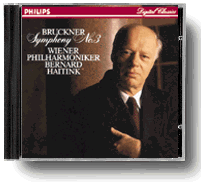


In 1873 Bruckner summoned up courage to ask Wagner if he could dedicate a symphony to him. He took the scores of the Second and Third Symphonies to Wahnfried, Wagner's house, and left them so that Wagner could decide on which he would preferred. The next day when Bruckner went to collect them, Wagner plied him with beer, doing his utmost to put Bruckner at ease. When he got back to the hotel, Bruckner realised to his horror that he had forgotten which symphony Wagner had said he wanted dedicated to him. So Bruckner wrote a note: "Symphony in D minor, where the trumpet begins the theme?" and Wagner, frantically busy, scrawled "Yes! Yes! Best wishes! Richard Wagner." After this meeting, Wagner always called the composer "Bruckner the Trumpet." Bruckner and Wagner, the two music giants of the Romantic Period, became great friends for a lifetime. Since it was dedicated to Wagner, the Third Symphony is also called "Wagner Symphony". It is absolutely the first important work of Brucknerís symphonic composition. However, the first performance of the symphony was a disaster. The audiences could not understand this enormous epic work, and many of them left early during the performance. Only tens of people stayed till the whole symphony was finished (Gustav Mahler was there). The failure of the performance was a great shock to Bruckner. In the next few years, he revised it again and again. That is why we have totally five versions of the work these days. Only in 1977, 81 years after the composerís death, was the original version published by Leopold Nowak. It was fortunate that the original was preserved in the dedication copy to Wagner: "To the unreachable world-famous noble Master of Poetry and Music."

 Georg Tintner
Georg Tintner


This performance of the 1873 original version was stunning and awesome. The 1888/89 version usually played today, which is around 55 minutes, is an emaciated version of the 77 minutes original recorded here by Tintner. The tempo never sounds slow. Tintner gives each thematic group time to present its themes in Bruckner's characteristic blocks of sound, and along the way he makes some fascinating discoveries. The interpretation is transcendent, sending shivers up and down one's spine. This Naxos recording is spacious and clean, giving this epic work an immediate impact.

 Bernard Haitink
Bernard Haitink


Haitink uses the 1877 version, edited by Nowak. His opening of the first movement is magnificent, with molding of phrase and rhythm beautifully judged, to bring natural flexibility within a strongly controlled structure. Haitink has meticulous concern for details, and he still conveys the epic drama of Brucknerís writing. This performance is full of breadth and majesty, and the playing of the Vienna Philharmonic Orchestra is first-class.

Other Recommendations:
George Szell

